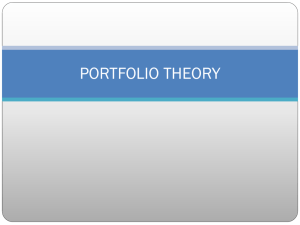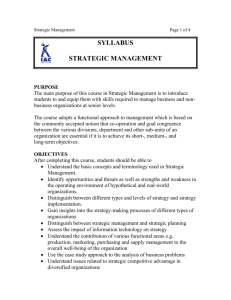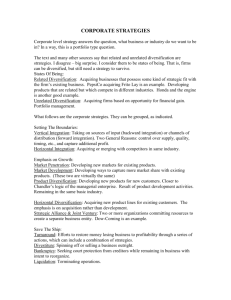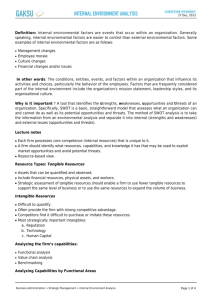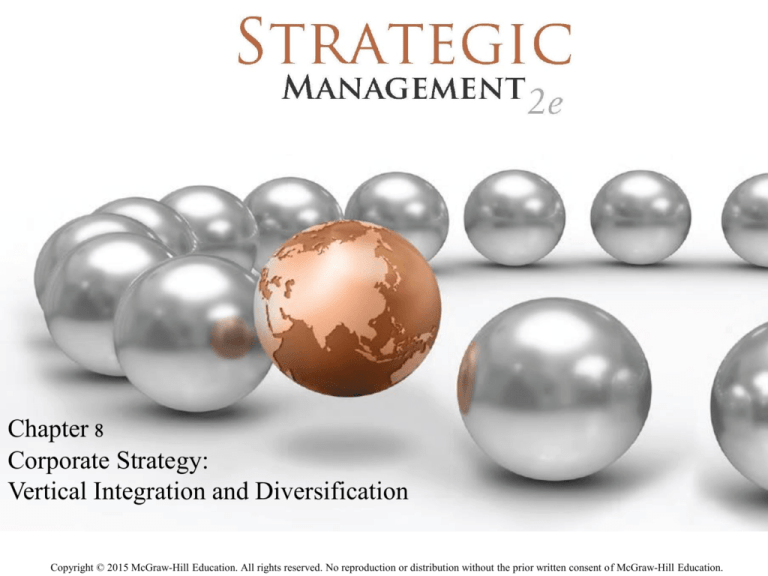
Chapter 8
Corporate Strategy:
Vertical Integration and Diversification
Copyright © 2015 McGraw-Hill Education. All rights reserved. No reproduction or distribution without the prior written consent of McGraw-Hill Education.
8-2
8.1 What Is Corporate Strategy?
CORPORATE-LEVEL STRATEGY
Corporate strategy determines the firm’s boundaries along
three dimensions:
1. Industry value chain
2. Range of products and services
3. Where to compete: geography
Key strategic management concepts used here:
•
•
•
•
Core competencies – unique strengths
Economies of scale – average cost per unit decreases
Economies of scope – savings producing two (or more) outputs
Transaction costs – all internal and external costs associated
with an economic exchange
8-3
8.2 The Boundaries of the Firm
TRANSACTION COST ECONOMIES
Explains and predicts the scope of the firm
• "Market vs. firms" have differential costs
External transaction costs
• Costs associated with economic exchanges
Ex: negotiating and enforcing contracts
Internal transaction costs
• Costs pertaining to organizing an exchange within a firm
Ex: recruiting & training employees
8-4
Exhibit 8.1 Internal and External
Transaction Costs
8-5
Firms vs. Markets: Make or Buy?
FIRST CORPORATE STRATEGY QUESTION
If Cin-house < Cmarket, then vertically integrate (make)
• Ex: Google hires programmers to write code in-house rather than
contracting out.
Disadvantage of “make” in-house
• Principal–agent problem
owner = principal, manager = agent
Disadvantage of “buy” from markets
• Search cost
• Opportunism
• Information asymmetries
These decisions determine the firm’s boundaries.
8-6
Alternatives on the Make-or-Buy
Continuum
Short-term contacts
• Competitive bidding process
• Less than one-year term
• Lower prices cost advantages
Strategic alliances
• Facilitate investment without administrative costs
Ex: Long-term contacts, equity alliances, joint ventures
Parent–subsidiary relationship
• Most integrated alternative
• Parent companies have command and control
Ex: GM owns Opel and Vauxhall in Europe
8-7
Exhibit 8.3 Alternatives on the
Make-or-Buy Continuum
8-8
Strategy Highlight 8.1
Toyota Locks Up Lithium for Car Batteries
World demand for lithium-ion batteries for cars
• Grew from $278 million in ‘09 to $25 billion in 2014
Toyota wants to secure long-term supply to power its
hybrid fleet of over 5 million hybrids sold.
Orocobre holds rights to a large lithium deposit.
• Upfront investment to extract of lithium is very high.
To encourage investment, Toyota invested $120 million
in an equity position.
8-9
8.3 Vertical Integration along the
Industry Value Chain
In what stages of the industry value chain should the
firm participate?
Vertical integration
• Ownership of its inputs, production, & outputs in the
value chain
• Vertical value chain
• Industry-level integration from upstream to downstream
Examples: cell phone industry value chain
• Many different industries and firms
8-10
Exhibit 8.4
Backward and Forward Vertical
Integration along an Industry Value Chain
8-11
Types of Vertical Integration
Full vertical integration
• Ex: Weyerhaeuser
• Owns forests, mills, and distribution to retailers
Backward vertical integration
• Ex: HTC’s backward integration into design of phones
Forward vertical integration
• Ex: HTC’s forward integration into sales & branding
Not all industry value chain stages are equally
profitable.
• Apple – designs in-house software and hardware but
partners for manufacturing
• Porter’s five forces (Chapter 3) useful tool here
8-12
Benefits and Risks of Vertical
Integration
SOME BENEFITS OF VERTICAL INTEGRATION
Securing critical supplies
Lowering costs & improving quality
Facilitating investments in specialized assets
SOME RISKS OF VERTICAL INTEGRATION
Increasing costs & reducing quality
Reducing flexibility
Increasing the potential for legal repercussions
8-13
Alternatives to Vertical Integration
Taper integration
• Backward integrated but also relies on outside market firms
for supplies
OR
• Forward integrated but also relies on outside market firms
for some of its distribution
Strategic outsourcing
• Moving value chain activities outside the firm's boundaries
Ex: PeopleSoft, EDS, and Perot Systems provide HR services to
many firms that choose to outsource it.
8-14
8.4 Corporate Diversification:
Expanding Beyond a Single Market
SECOND CORPORATE STRATEGY QUESTION
Degrees of diversification
• Range of products and services a firm should offer
Ex: PepsiCo also owns Lay's & Quaker Oats, but sold off KFC
Differences in corporate strategy between KFC & Chick-fil-A
Diversification strategies
• Product diversification
Active in several different product categories
• Geographic diversification
Active in several different countries
• Product–market diversification
Active in a range of both products and countries
8-15
Types of Corporate Diversification
Single-business firm derives >95% from one business
Google revenues from online search
Dominant-business firm 70% to 95% from one business
Harley-Davidson yields 10% revenues from clothing
Related diversification strategy <70% from one business
• Related-constrained – leverage current competencies
ExxonMobil strategic move into natural gas
• Related-linked – share only limited links to current business
Amazon move into cloud computing, Kindle tablets, & video streaming
Unrelated diversification <70% and few if any links
among businesses (a conglomerate)
GE, LG, Tata
8-16
RELATED
DIVERSIFICATION
Economies of scale &
scope
Sharing product/
service, technology,
distribution resources
UNRELATED
DIVERSIFICATION
Financial economies
•Restructuring
•Internal capital
markets
8-17
Leveraging Core Competencies for
Corporate Diversification
Core competence
• Unique skills and strengths
• Allows firms to increase the value of product/service
• Lowers the cost
Examples of core competencies are:
• Walmart − globally distributed supply chain at low cost
• Infosys − high-quality/low-cost IT services
The core competence – market matrix
• Provides guidance to executives on how to diversify in
order to achieve continued growth
8-18
Corporate Diversification and Firm
Performance
Does corporate diversification lead to superior
performance?
The critical question to ask:
• Are the individual businesses worth more under the
company’s management than if each were managed in
separate firms?
Research finds an inverted U-shaped relationship
• Type of diversification
• Overall firm performance
8-19
Exhibit 8.9 The DiversificationPerformance Relationship
8-20
RESTRUCTURING
The process of reorganizing and divesting
business units such as GE in ChapterCase 8
• InBev sold Busch Gardens and SeaWorld to focus
on core.
Boston Consulting Group (BCG) growth-share
matrix
• Build market share with stars and question marks.
• Hold market share with cash cows.
Harvest (milk) as much short-term cash as possible.
• Divest a dog business unit.
8-21
Exhibit 8.11 Restructuring the
Corporate Portfolio:
The Boston Consulting
Group Growth-Share Matrix
8-22
8.5 Implications for the Strategist
Effective corporate strategy helps to gain and sustain a
competitive advantage.
Corporate strategy needs to be dynamic over time.
• GE CEO Jeffrey Immelt formulated a new corporate
strategy in clean-tech and health care. (ChapterCase 8)
• Strategic positions of Nike and adidas another example
adidas founded in 1924 focused on athletic shoes
Integrated manufacturing model
Globalization led adidas to less integration and wider sports apparel
2013 − 40% shoes, 50% apparel, 10% equipment
Nike started in 1978 as a vertically disintegrated firm.
8-23
Take-Away Concepts
LO 8-1
Define
corporate
strategy and
describe the
three
dimensions
along which it
is assessed.
Corporate strategy addresses “where to
compete.” Business strategy addresses
“how to compete.”
Corporate strategy concerns the boundaries
of the firm along three dimensions: (1)
industry value chain, (2) products and
services, and (3) geography (regional,
national, or global markets).
To gain and sustain competitive advantage,
any corporate strategy must support and
strengthen a firm’s strategic position,
regardless of whether it is a differentiation,
cost-leadership, or integration strategy.
8-24
Take-Away Concepts
LO 8-2
Describe and
evaluate
different
options firms
have to organize
economic
activity.
Transaction cost economics help managers decide
what activities to do in-house (“make”) versus to
obtain from the external market (“buy”).
When the costs to pursue an activity in-house are
less than the costs of transacting in the market, then
the firm should vertically integrate.
Principal–agent problems and information
asymmetries can lead to market failures.
A principal–agent problem arises when an agent
performing activities on behalf of a principal
pursues his or her own interests.
Information asymmetries arise when one party is
more informed than another.
Moving from less integrated to more fully integrated
forms of transacting, alternatives include short-term
contracts, strategic alliances, and parent–subsidiary
relationships
8-25
Take-Away Concepts
LO 8-3
Describe the
two types of
vertical
integration
along the
industry value
chain: backward
and forward
vertical
integration.
Vertical Integration
• Denotes a firm’s value added—what percentage of a
firm’s sales is generated within a firm’s boundaries.
Industry Value Chains
• (Vertical value chains) depict the transformation of
raw materials into finished goods and services.
• Each stage typically represents a distinct industry in
which a number of different firms are competing.
Backward Vertical Integration
• Moving ownership of activities upstream nearer to the
originating (inputs) point of the industry value chain.
Forward Vertical Integration
• Moving ownership of activities closer to the end
(customer) point of the value chain.
8-26
Take-Away Concepts
LO 8-4
Identify and
evaluate
benefits and
risks of
vertical
integration.
Benefits of Vertical Integration
•
•
•
•
•
Securing critical supplies
Lowering costs
Improving quality
Facilitating scheduling and planning
Facilitating investments in specialized assets
Risks of Vertical Integration
•
•
•
•
Increasing costs
Reducing quality
Reducing flexibility
Increasing the potential for legal repercussions
8-27
Take-Away Concepts
LO 8-5
Describe and
examine
alternatives to
vertical
integration.
Taper Integration
• Strategy in which a firm is backwardly integrated but also
relies on outside-market firms for some of its supplies,
and/or is forwardly integrated but also relies on outsidemarket firms for some if its distribution.
Strategic Outsourcing
• Moving one or more value chain activities outside the
firm’s boundaries to other firms in the industry value
chain.
• Off-shoring is the outsourcing of activities outside the
home country.
8-28
Take-Away Concepts
LO 8-6
Describe and
evaluate
different types
of corporate
diversification.
A single-business firm derives 95% or more of
its revenues from one business.
A dominant-business firm derives between 70
and 95% of its revenues from a single business,
but pursues at least one other business activity.
A firm follows a related diversification strategy
when it derives less than 70% of its revenues
from a single business activity, but obtains
revenues from other businesses linked to the
primary business activity. (related-constrained
or related-linked)
A firm follows an unrelated diversification
strategy when less than 70% of its revenues
come from a single business, and there are few,
if any, linkages among its businesses
8-29
Take-Away Concepts
LO 8-7
Apply the core
competence–
market matrix
to derive
different
diversification
strategies.
When applying an existing/new dimension to core
competencies and markets, four quadrants emerge,
depicted in Exhibit 8.8.
The lower-left quadrant combines existing core
competencies with existing markets. Consider ideas of
how to leverage existing core competencies to improve
their current market position.
The lower-right quadrant combines existing core
competencies with new market opportunities. Consider
how to redeploy and recombine existing core
competencies to compete in future markets.
The upper-left quadrant combines new core competencies
with existing market opportunities. Consider strategic
initiatives of how to build new core competencies to
protect and extend the firm’s current market position.
The upper-right quadrant combines new core
competencies with new market opportunities. This is
likely the most challenging diversification strategy
because it requires building new core competencies to
create and compete in future markets
8-30
Take-Away Concepts
LO 8-8
Explain when a
diversification
strategy creates
a competitive
advantage and
when it does
not.
The diversification-performance relationship is a function of the
underlying type of diversification.
The relationship between the type of diversification and overall
firm performance takes on the shape of an inverted U (see
Exhibit 8.9).
Unrelated diversification often results in a diversification
discount: the stock price of such highly diversified firms is
valued at less than the sum of their individual business units.
Related diversification often results in a diversification premium:
the stock price of related-diversification firms is valued at
greater than the sum of their individual business units.
In the BCG matrix, the corporation is viewed as a portfolio of
businesses, much like a portfolio of stocks in finance (see
Exhibit 8.11). The individual SBUs are evaluated according to
relative market share and the speed of market growth, and are
plotted using one of four categories: dog, cash cow, star, and
question mark. Each category warrants a different investment
strategy.
Both low levels and high levels of diversification are generally
associated with lower overall performance, while moderate
levels of diversification are associated with higher firm
performance.
8-31
8-32


